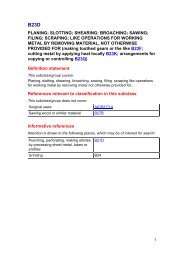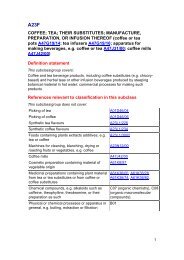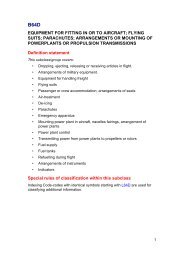A61K - Cooperative Patent Classification
A61K - Cooperative Patent Classification
A61K - Cooperative Patent Classification
You also want an ePaper? Increase the reach of your titles
YUMPU automatically turns print PDFs into web optimized ePapers that Google loves.
CPC - <strong>A61K</strong> - 2013.07 - page 57<br />
peptidic linker are classified in <strong>A61K</strong> 47/48338 )<br />
NOTE<br />
-<br />
The connection of the drug to the peptide, protein or polyamino acid can<br />
be by a direct covalent linkage or through a linker Fusion/chimeric proteins<br />
genetically produced, e.g. by recombinant DNA technology, are classified<br />
in C07K 2319/00 and subgroups, not in <strong>A61K</strong> 47/48246 and subgroups.<br />
<strong>A61K</strong> 47/48246 and its subgroups only cover the conjugates wherein a<br />
peptide or protein being the pharmacologically or therapeutically active<br />
agent has been linked to another peptide or protein being the modifying<br />
agent via chemical methods. In that latter example of a<br />
chemically-produced peptide or protein-peptide or protein conjugate, what<br />
being classified in <strong>A61K</strong> 47/48246 or in one of its subgroups being the<br />
peptide or protein used as modifying agent<br />
<strong>A61K</strong> 47/48253 . . . . { the peptide, protein or polyamino acid in the drug conjugate being a<br />
branched, dendritic or hypercomb peptide }<br />
<strong>A61K</strong> 47/48261 . . . . { the peptide or protein in the drug conjugate being a toxin or a lectin, e.g.<br />
clostridial toxins or Pseudomonas exotoxin }<br />
<strong>A61K</strong> 47/48269 . . . . { the peptide or protein in the drug conjugate being a cytokine, e.g. IL2,<br />
chemokine, growth factors, interferons being the inactive part of the<br />
conjugate }<br />
NOTE<br />
-<br />
ligands of growth factors are not classified here<br />
<strong>A61K</strong> 47/48276 . . . . { the peptide or protein in the drug conjugate being a receptor as such, e.g.<br />
CD4; a cell surface antigen ( therefore not a peptide ligand targeting the<br />
antigen ) ; a cell surface determinant, i.e. a part of the surface of a cell }<br />
NOTE<br />
-<br />
a peptide targeting a receptor being not classified here<br />
<strong>A61K</strong> 47/48284 . . . . { the peptide or protein in the drug conjugate being an albumin, e.g. HSA,<br />
BSA, ovalbumin, or a Keyhole Limpet Hemocyanin (KHL) }<br />
<strong>A61K</strong> 47/48292 . . . . { the peptide or protein in the drug conjugate being a connective tissue<br />
peptide, e.g. collagen, fibronectin, gelatin }<br />
<strong>A61K</strong> 47/483 . . . . { the peptide or protein in the drug conjugate being a transferrin, e.g. a<br />
lactoferrin or ovotransferrin }<br />
<strong>A61K</strong> 47/48307 . . . . { the peptide or protein in the drug conjugate being a haemoglobin }<br />
<strong>A61K</strong> 47/48315 . . . . { the peptide or protein in the drug conjugate being a polycationic or<br />
polyanionic oligopeptide, polypeptide or polyamino acid, e.g. polylysine,<br />
polyarginine, polyglutamic acid, peptide TAT }<br />
<strong>A61K</strong> 47/48323 . . . . . { polyanionic oligopeptide, polypeptide or polyamino acid, used to<br />
complex nucleic acids being the therapeutic agent }<br />
<strong>A61K</strong> 47/4833 . . . . { the entire peptide or protein drug conjugate elicits an immune response,<br />
e.g. conjugate vaccines }<br />
NOTE<br />
-<br />
Haptens, e.g. conjugate of morphine or nicotine and KLH inducing an<br />
immune response being classified in <strong>A61K</strong> 47/4833 and <strong>A61K</strong>





